Groundwater licensing and trading – the case of the state of Victoria, Australia
licensing and trading
Download the practice
People in charge of the innovative practice :
Not known


Responsible entity
The Victorian water market design comprises several participants (Fig. 1), from individual entitlement holders to water corporations. The Victorian Minister for Water has the overall responsibility for market design while other entities, such as Murray-Darling Basin Authority, push to remove artificial barriers to water trade and prevent insider trading and discrimination for traders. Water corporations are responsible for assessing applications for water shares trading (DELWP, 2019a). The Crown delegates authority to government departments and water corporations to develop and manage groundwater resources for all users and the environment.
Water corporations are divided into three categories: (1) Urban-metropolitan (Melbourne area), (2) Urban-regional (provide water and sewerage services in regional cities and towns across the state) and (3) Rural water (provide rural water services for irrigation, stock and domestic, environmental and recreational purposes).
Victoria state has eighteen government-owned water corporations which responsibilities include: (1) the supply of drinking and recycled water, and the removal and treatment of sewage and trade waste – known as ‘urban’ water services – and (2) water delivery for irrigation, domestic and stock purposes, drainage, and salinity mitigation – known as ‘rural’ water services.
Some of these water corporations also provide water for environmental purposes, manage bulk water storage, and designated recreational areas, and help the Minister for Water operate the Victorian Water Register.
Water corporations operate and maintain treatment plants, pumping stations, pipes, channels, reservoirs, dams, gates and meters.
Groundwater licencing and trading for all uses except urban supply in the state of Victoria is implemented by rural water corporations – Southern Rural Water, Goulburn-Murray Water, Grampians Wimmera Mallee Water and Lower Murray Water (Fig. 2)
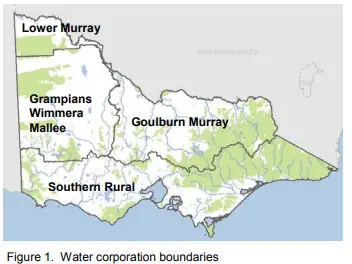
Detailed explanation
Water trading is a necessary tool when the water resource available for commercial or intensive use (i.e., irrigation) is fully allocated (DPI, 2012). This trading system may be useful or necessary for users who, for example, have a licence but no longer need all of it or intend to expand, implement water use efficiency measures, or require more water to get through a dry season
The basis for this market is a water entitlement. Entitlement holders are responsible for managing their own water needs as well as the risks of any water scarcity. These entitlements are protected by a statutory framework that ensures the amount of water that can be taken is capped and makes it an offence to take water without authorization (DELWP, 2019a). The cap is established yearly which prevents new entitlements from being issued, to protect the resource and prevent it from being depleted or causing adverse impacts such as reduction of base-flows in rivers/streams, changes in quality and saltwater intrusion.
The entitlements issued under de Victorian Water Act are of different types depending on expected use and are recorded in the Victorian Water Register. This platform provides information on the entitlement volumes, transactions, allocations, and trade.
The entitlements have several types depending on use, from bulk/environmental, individual arrangements or supply arrangements. As an example, individual entitlements are held as a licence, also referred to as a “take and use” or a “section 51 licence”. The licence includes the location for where the water can be taken and the land where it can be used, not allowing for the construction of infrastructures to retain or extract water. might include limits to annual and daily extraction rates. Licences allow water to be extracted on annual basis from July 1st to June 30th (DPI, 2012).
When the cap has been reached, both in surface and groundwater systems, a user may transfer his licence permanently or temporarily. Water trades must be assessed and approved by the issuing water corporation, ensuring that there aren’t any adverse impacts on other users or the environment. Trading water entitlements is a private negotiation between buyer and seller, set by open market rules. This process is usually initiated by advertisement. The prices may be evaluated by consulting the Victorian Water Register or a water broker.
Water allocation is the amount of water distributed yearly to different. This volume change according to rainfall, inflows and how much water is stored (Fig. 6).
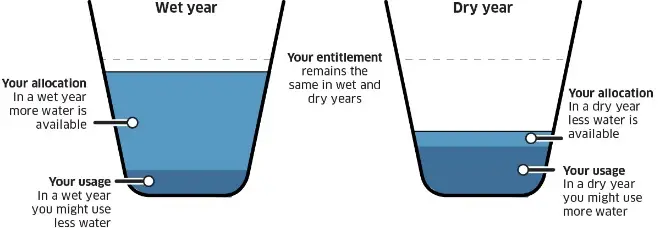
Concerning groundwater trading, a permissible consumptive volume (PCV) – the maximum volume of water that can be allocated in an area – is set by the government. PCVs are imposed to protect the resource and prevent it from being depleted or causing adverse impacts such as:
- loss of water supply
- reduced base flows in rivers and streams
- changes to water quality/saline intrusion.
Groundwater Management Units have been established as a part of the framework for managing groundwater reserves. These units cover 24% of the state and are of two types: GMA (1) groundwater management areas – GMA (2) water supply protection areas – WSPA (Fig. 7). GMAs are areas where groundwater has been intensively explored or has the potential to be developed. WSPAs are declared by the government to protect stressed groundwater or surface water resources through the implementation of a management plan. Unincorporated Areas are areas where the resource is low yielding, or its quality has traditionally severely limited its use (low development) – PCVs do not apply.
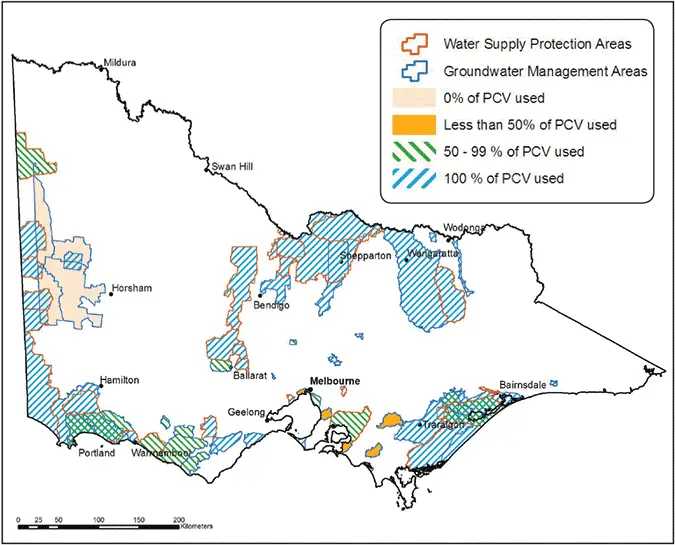
In areas where PCV is fully allocated, no new licences can be issued and trading with an existing groundwater licence holder is the only way to acquire groundwater.
Under the Murray-Darling Basing Plan framework, water trading is prohibited unless a specific set of conditions is met:
- there is sufficient hydraulic connectivity between the extraction points subject to the trade
- the trade is within the consumptive limit for extraction from the resource
- a mechanism is in place to account for trade such as the Victorian Water Register
- the characteristics of the entitlement are maintained (such as volume, timing and conditions), subject to conversion rates
- measures are in place to address third party impacts (DELWP, 2019a)
Rural Water Corporations are responsible for assessing license applications, deciding whether to issue licenses and the terms and conditions on which a license is issued (DPI, 2012). Those entities will consider a range of matters when assessing groundwater license applications including:
- whether there is any water available for allocation under the PCV for the area
- any restrictions required by an approved management plan for any groundwater supply protection area
- any adverse effect that the allocation or use of groundwater might have (i.e., impacts on existing authorized users; a waterway or aquifer; the drainage regime; or the environment)
- any water the applicant is already entitled to the purposes for which the water is to be used.
Licenses are issued for between 1 year and 15 years with conditions relating to the exact location and depth from which groundwater can be extracted, the annual volume of water that can be pumped and the rate at which pumping can occur. When making a license application, applicants may be required to undertake investigations commensurate with the volume applied for. These investigations may include pumping tests and environmental impact reports to ensure the extraction will have no adverse effects.
Finally, the Carryover concept must be considered. This was initially introduced in northern Victoria in 2007 as an emergency drought response measure and allowed for water not used in a season to be taken and used into the next. Carryover gives water entitlement holders flexibility to hold, use or trade their water when it’s of greatest value to their business. This helps to manage risks, to prepare for shortages due to drought and to secure water for the start of the season, allowing irrigators to set up their farming business for the year. Carryover may help to reduce reliance on the market to meet water needs in future years. This is particularly valuable going into dry years when market prices are highest.
Groundwater carryover operates on the same principles as surface water enables the licence holder to carry over a fixed percentage of their unused licence volume to the following year, with no deduction for losses or evaporation.
Replication potential in SUDOE region
Before the establishment of water markets in any area, four broad elements are needed to drive efficient use and outcomes (Wheeler et al., 2016):
- A fixed limit to resource availability based on accurate science, monitored and sustainably explored.
- Secure property rights in the form of entitlements.
- Water allocated seasonally is tradeable under low transaction costs and entry/exit barrier conditions, allowing dynamic ownership over time.
- Prices are established in a market that uses the value placed on water use by a large pool of buyers and sellers.
For groundwater markets, there need to be well-defined rights with limited groundwater use allocations and monitoring of groundwater extraction by all users. These rights and allocation levels need to be based on a good understanding of the hydrogeology of a groundwater area, groundwater mobility and its sustainable yield, along with knowledge of dependent ecosystems and the way the aquifer responds to extraction. This is particularly relevant in scarcity prone regions such as southern Europe.
A similar platform to the Victorian Water Register is fundamental to the good implementation of the modern water market. This public register holds all water-related entitlements in Victoria and has been designed to provide crucial information for managing the state’s water resources. Such platform must, in a similar matter:
- hold water shares, together with mortgages and limited term transfers (leases) relevant to these water shares, licenses to take and use both surface and groundwater and respective seasonal allocations
- track volumes of water entitlements by water system and trading zone as well as the inventory of water-use licenses and delivery shares that are managed entities similar to water corporations
- include workflows to process water dealings, keep audit trails and generate statistics and reports on levels of use, directions of trade, and prices paid
Although similar approaches have been introduced in Spain, in the Sudoe Region, water management is generally based on the common property regime, holding collective resource use rights and excluding permanent individual appropriation of natural resources (Rinaudo et al., 2020).
Future outlook
Victoria’s water market has emerged and grown rapidly (Lewis et al., 2001). Groundwater markets are less common than surface water markets, but some exist in also in China, Oman, India United States. Comparatively, those are harder to implement than surface water markets that occur mainly in semiarid regions (United States, Chile, Spain, Canada, South Africa, China, Brazil, Mexico and Tanzania (Wheeler et al. 2016).
Although groundwater trading may be difficult to implement due to the intrinsic characteristics of this resource, with the support of Big Data and modern increased computational power, this seems like an achievable goal at a national scale and possibly at a European scale.
Institutional setting
The Victorian Water Act (No. 80 of 1989) provided the necessary regulatory framework for the state management of water resources and defined a system of rights and entitlements which laid bases for water trading. The Act aimed to provide for the integrated management of all elements of the terrestrial phase of the water cycle, to promote the orderly, equitable and efficient use of water resources and to make sure that water resources are conserved and properly managed for sustainable use for the benefit of present and future Victorians. It also pushed for the maximization of community participation in making and implementing plans related to the use and protect water. Under the Act, the State Government has the right to the use, flow and control of all water in a waterway as well as all groundwater for the benefit of the community, users and the environment.
Fully functional water markets begin to arise under the Australian National Water Initiative (NWI) which defines a nationally compatible, market, regulatory and planning based system of managing surface and groundwater resources for rural and urban use that optimises economic, social and environmental outcomes. This forced states and territories are to adopt water planning regimes that allow for the clear articulation of the trade-offs between the achievement of ecological and consumptive water uses. Murray-Darlin Basin was recognized in NWI as a priority area for protection, due to its national importance. A plan for investment in water infrastructure, the purchase of water on the market, and changes to river or wetland management was laid
The development of the Murray-Darling Basin Plan was instrumental in implementing and guiding water trading. This important management tool determines an average amount of water that can be extracted or taken annually from the Murray-Darling Basin for consumptive use (urban, industrial and agricultural), called the sustainable diversion limit (SDL) (DELWP, 2019a).
Geographical setting
Victoria is a southern state which represents 3% of Australia’s total area and it is characterized by the second-highest population density in Australia. It is a very economically relevant region as it represents 23% of the country GDP. Historically mining occurred over a large proportion of the state’s area in the XIX century and water management issues were then common. The economical importance of agriculture increased and today Victoria is the largest supplier of premium food and fibre products, exporting 77% of Australia’s dairy exports, 50% of Australia’s horticultural exports and 32% per cent of Australia’s prepared food exports. This sector represents most of the water consumption in the territory – Fig. 3.
Although Victoria is the second wettest Australian State, between 1996 and early 2010 experienced unprecedented dry conditions, the Millennium Drought. More than 50% of the state experienced the lowest rainfall on record (particularly for the 2006/07 hydrological year) – Fig. 4 (DELWP, 2016).
Water shortage was exacerbated by water quality problems such as algal blooms or contamination resulting from wildfires, reducing the availability of clean water and supply shortages in many regions across the state. This extreme event ended in major flooding events in 2010/11 and highlighted the need for dynamic planning, which has served to reinforce the relevance of Victoria’s water entitlement, planning framework and principles, based on the uncertainty surrounding a wide range of plausible future climate scenarios.
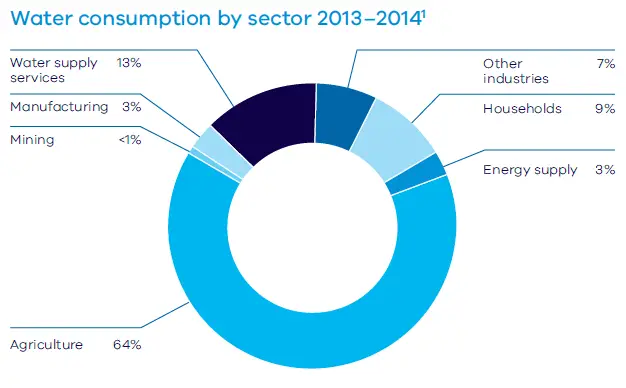
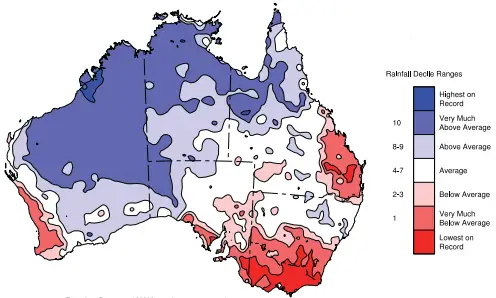
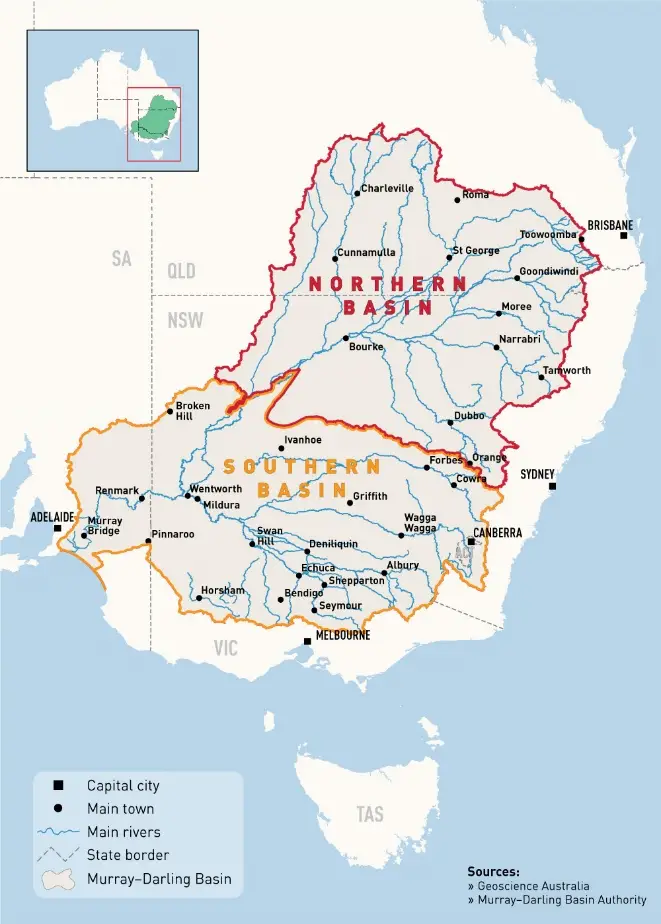
Historical overview
The main steps in developing a water market in Victoria started in 1905/09 with legislation setting um water rights with an annual charge based on volumes available in the land. In the 1940s there is a record of informal short-term transfers during severe WWII drought that hit the region. From the 1970s through to the 1990s, state governments undertook initiatives to sustainably manage land and water while facing water deterioration. In 1981 there is a recommendation that allocations of water should be market-driven and in 1987 the temporary transfer of water rights start. The framework for trading is fully developed in 1989 with the Water Act. Official trading starts in 1991 with successive updates and revisions, while in 1996 the volume cap is introduced. In 1998 the Northern Victorian Water Exchange starts operation and will later (Lewis et al., 2001) be supported by the Victorian Water Register platform. In 2007, Water Act provided the modern legislative framework for water trading and established the Murray-Darling Basin Authority. Under the actual framework, water trading allowed for the relative stabilization of available water under different hydrological conditions (Fig. 8)
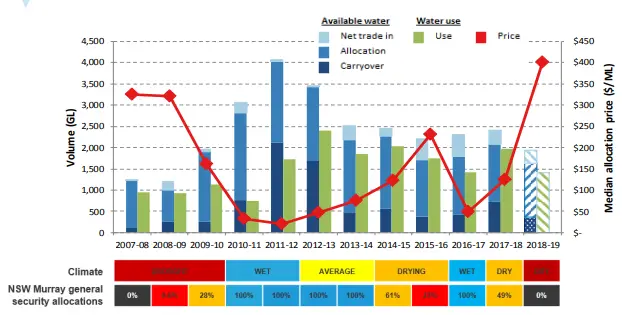
Fig. 8 – Allocation price
Evidence of benefits from implementation
Fig. 8 illustrates how allocation prices vary depending on water availability in northern Victoria, climatic conditions and water availability in the upstream New South Wales (NSW) Murray section. Upstream water availability has a very strong influence on market prices in Victoria. In 2018-19, market prices have risen sharply due to drought in NSW and hot and dry conditions that have resulted in increased competition for water to meet irrigation demands in the southern Murray-Darling Basin. This is also associated with reduced water availability with zero general security allocations in the NSW Murray and lower carryover in northern Victoria and externalities such as commodity prices for many key horticultural crops.
Little information is available on the status of the groundwater trading market in the state. In 2011 it was reported by National Water Commission (NWC, 2011 in Wheeler et al., 2016) that groundwater trade is comparatively much less developed in Victoria than in New South Whales. It was reported In Victoria, less than half of the Groundwater Management Units are considered over-allocated, while 12 % are considered less than 50 % allocated. This resulted that within under-allocated units, new licenses are being issued with a decreased incentive for trade. However, it was also reported that groundwater levels are declining which coupled with the predicted consequences of climate change and expected decrease in natural recharge, demand for trade is bound to increase.
The report also pointed that a barrier to groundwater trade is the lack of planning for management of groundwater resources. For example, in water supply protection areas, trading is not permitted until a management plan has been developed. Delays with the development are associated with a lack of knowledge about aquifers and sustainable yields – again due to historical reliance on surface water systems and a lack of development on groundwater (Wheeler et al., 2016; DELWP, 2018). Surface and groundwater interaction is also key information in established caps which is sometimes a difficult task (Aither, 2017).
Not specifically related to the groundwater market but to the general water trading operation in Victoria allowed for environmental benefits to be achieved. The Victorian Environmental Water Holder (VEWH), responsible for holding and managing Victoria’s environmental water entitlements, reported uses of environmental water in a coordinated way through exchanges maximised water availability across all regions, allowing for the return of unused water to the source environmental water holder. A large proportion of trade by us is simply moving water between systems and environmental water accounts. For instance, a transfer of water allocated to the Commonwealth Environmental Water Holder was transferred into VEWH to use in northern Victorian rivers and floodplains in 2014-15 which benefited several lakes and resulted in golden perch spawning in the Goulburn River and improving fish passage and habitat.
DELWP (2016) has emphasized that market participants are becoming more sophisticated in how they manage and trade water and that the market has changed because the pool of consumptive water entitlements has been reduced by the recovery of water for the environment (Fig. 9). The recovery of water for the environment and the increase in perennial horticulture and changes to the traditional irrigation landscape are altering the dynamics of the water market which has created economic value for Victoria’s irrigators. This allowed some irrigators to expand their high-value, water-dependent irrigated enterprises, while other irrigators have improved their economic wellbeing by selling either permanent or temporary entitlements. During drought conditions, irrigators use the market to manage production and financial risks; alleviating the economic losses associated with scarcity (Department of Sustainability and Environment, 2008).
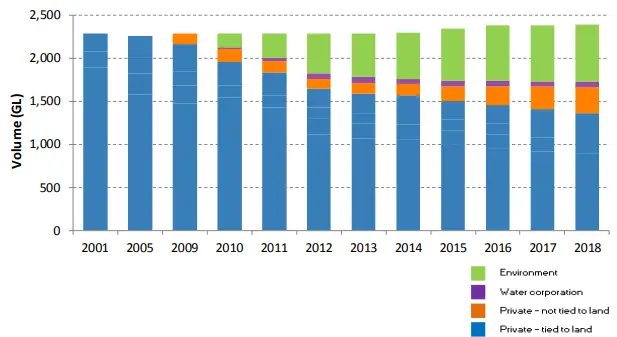
Key points of the innovative method
- Water licence trading is a market regulated system in which entitlement holders can decide the amount of water to use seasonally based on their business model, and freely trade the surplus/unused volumes
- The water market is subject to price fluctuations reflecting hydrological conditions (wet/dry years)
- Water is allocated by entitlements in response to storage levels and rainfall. Allocation is the amount of water distributed to users each year
- The water market created incentives for water to be used in higher-value uses as well as improved water usage (i.e., better irrigation methods and environmental purposes).
- Groundwater trading is comparatively more difficult to implement due to the difficulty to clearly evaluate this resource availability, lack of monitoring and knowledge.
Acknowledgements
This innovative practice was suggested by João Simão Pires from the Portuguese Water Partnership (PWP).
References
Aither, 2017. Trends in groundwater trade in Victoria. Final report prepared for the Victorian Department of Environment, Land, Water and Planning https://www.waterregister.vic.gov.au/images/documents/Water-Market-Trends-Fact-Sheet-1_Ownership-of-water-entitlements.pdf
DELWP, 2016. Managing extreme water shortage in Victoria: lessons from the Millennium Drought. ISBN: 978-1-76047-046-3. https://nla.gov.au/nla.obj-2804168353
DELWP, 2018. Victorian Water Market Effectiveness. Findings and actions from the 2017 Review. ISBN: 978-1-76077-032-7. https://www.waterregister.vic.gov.au/images/documents/Victorian%20water%20market%20effectiveness_findings%20and%20actions.pdf
DELWP, 2019a. Victoria’s North and Murray water resource plan: comprehensive report. https://www.water.vic.gov.au/murray-darling-basin/mdbp/water-resource-plans
DELWP, 2019b. Water Market Trends. Allocation Prices, Supply and Demand. ISBN: 978-1-76077-538-4. https://www.waterregister.vic.gov.au/images/documents/Water-Market-Trends-Fact-Sheet-3_Allocation-prices-supply-and-demand.pdf
DELWP, 2019c. Water Market Trends. Ownership of Water Entitlements. ISBN: 978-1-76077-538-4. https://www.waterregister.vic.gov.au/images/documents/Water-Market-Trends-Fact-Sheet-1_Ownership-of-water-entitlements.pdf
Department of Sustainability and Environment, 2008. Water trading in Northern Victoria 1991/92-2005/06: technical report. https://www.waterregister.vic.gov.au/images/documents/Water%20Trading%20in%20Northern%20Victoria%201991-92%20-%202005-06.pdf
DPI, 2012. Trading water licences for groundwater and unregulated surface water in Southern Victoria. Dept. of Primary Industries, Melbourne. ISBN: 978-1-74326-155-2
Grafton, R.Q., Connell, D., 2011. Basin Futures Water reform in the Murray-Darling Basin. ANU Press, Canberra. ISBN: 978-1-921862-25-0
Lewis, D., Victoria, Department of Natural Resources & Environment, 2001. The value of water: a guide to water trading in Victoria. Dept. of Natural Resources and Environment, East Melbourne, Vic. ISBN: 0 7311 5029 5 https://www.waterregister.vic.gov.au/water-trading/trade-reports
Murray-Darling Basin Commission (Australia), M.-D.B.C. (Australia), 1999. Murray-Darling Basin groundwater: a resource for the future. The Commission, Canberra.
Rinaudo, J.-D., Barnett, S., Holley, C., 2020. Changing from Unrestricted Access to Sustainable Abstraction Management Regimes: Lessons Learnt from France and Australia, in Rinaudo, J.-D., Holley, C., Barnett, S., Montginoul, M. (Eds.), Sustainable Groundwater Management, Global Issues in Water Policy. Springer International Publishing, Cham, pp. 537–562. https://doi.org/10.1007/978-3-030-32766-8_27
Wheeler, S.A., Schoengold, K., Bjornlund, H., 2016. Lessons to Be Learned from Groundwater Trading in Australia and the United States, in Jakeman, A.J., Barreteau, O., Hunt, R.J., Rinaudo, J.-D., Ross, A. (Eds.), Integrated Groundwater Management. Springer International Publishing, Cham, pp. 493–517. https://doi.org/10.1007/978-3-319-23576-9_20
INTERNET REFERENCES:
Victorian Groundwater Licencing and Trading (https://earthresources.vic.gov.au/legislation-and-regulations/guidelines-and-codes-of-practice/groundwater-licensing-and-trading)
Victorian Water Act 1989 (https://www.legislation.vic.gov.au/in-force/acts/water-act-1989/134)
Victoria DELWP Water and Catchments (https://www.water.vic.gov.au/)
Victoria’s economy (https://global.vic.gov.au/victorias-capabilities/why-melbourne/victorias-economy)
Murray Darling Basin Authority (https://www.mdba.gov.au/)
aquifer
news
Discover more on the Aquifer project news and on aquifer management
aquifer news
Description and objectives of the project
The scientific community recommends a substantial improvement in the knowledge of aquifers, the establishment of reliable monitoring networks and a greater involvement of the administration and users to achieve a sustainable management of aquifers. The main objective...
Information on the project
The Llobregat Delta Water Users' Community has designed recharge basins in Molins de Rei to recharge the Baix Llobregat aquifer. View of one of the reloading basins during the test phase The Llobregat Delta Water Users' Community is one of the nine partners in the...
Success stories in groundwater management
Compilation of groundwater management success stories completed. Throughout April, the 30 cases of innovative practices in groundwater management have already been selected by the clusters participating in the project: PPA, CWP and AV. The task started with the...
PROPOSE AN
INNOVATIVE PRACTICE
You are in charge of an innovative practice regarding aquifer management and you want to referenced it on the Aquifer platform ?
Fulfill the form and propose it to the Aquifer partners.
THE EBOOK
Aquifer offers a range of innovative water management practices. You can download all our fact sheets here.
e-book of innovative practices
DOCUMENTATION
To go further on information related to the management of aquifers